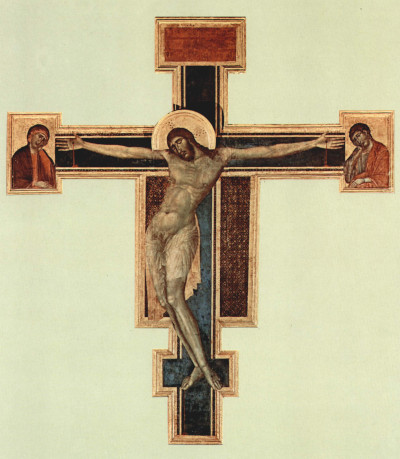This Crucifix by Cimabue at Santa Croce was produced whilst the artist was in his mid-twenties, and has experienced a turbulent existence.
Introduction
Cimabue worked on two large crucifixes within his career, as far as we can tell, with the alternative Arezzo version appearing just a few years later. The artist kept many elements of the two the same, suggesting that he was pleased with this first version. As he moved on, the follow up crucifix featured a more defined stomach, as well as an additional portrait to the top of the piece.
With Cimabue starring as early as the 13th century, there remains many questionmarks around his career, such as the precise dates of specific items as well as details on his life and artistic journey. His Santa Croce Crucifix actually enjoys a greater understanding than most items from his career, though there still remains a small minority of scholars who are hesitant as to its attribution to Cimabue.
Description
This crucifix captures the traditional format in which Christ is pictured in a vulnerable posture, with his arms outstretched. His head leans to one side whilst his stomach and waist follow in the same direction. His hands reach out to the edges of the horizontal structure, with two portraits then facing inwards on either side.
Christ is given a golden halo which signifies his divinity, and this was a common touch within Italian art of this period. Further rectangles of color are added beneath and above the stricken Christ, with simple tones of red, purple and blue filling them without any complex detail.
Cimabue pictures Christ was particularly slim arms, with little muscle. This increases the feeling of desperation on his part, and adds to the overall theme of suffering and sacrifice. One might also argue that technically, the limbs have been extended a little beyond reality, which many artists have done over the centuries - there has been a constant variation in balance between expression and accuracy, across many art movements.
Florence Flood of 1966
This catastrophic flood across Florence in the 1960s would damage many Italian masterpieces. Whilst the church of Santa Croce had already been flooded several times since the crucifix had been installed, it was not until this moment that the crucifix itself would be damaged. Much paint was lost, and its alternative location in a museum left it more vulnerable.
Restoration work has been completed to restore much of the original look, but its condition can be described as fragile, due to the combination of age, material, and the impact of the flooding.
Additional Portraits
The two portraits which face inwards towards Christ's body, and continue the mood of sadness and reflection are believed to represent The Virgin, and John the Evangelist. Efforts were made by the artist to ensure these remaining supporting elements only, and that the main focus remains on Christ himself, in accordance with the original narrative from the Bible.
Details of the Crucifix
The crucifix is around four metres in height and width. The construction features several different wooden panels which have been arranged together, and the artist used the traditional techniques of distemper to apply the paint. This method was not ideally suited to lasting centuries, and so considerable restoration has been required over the years to avoid the colors and forms disappearing.
Conclusion
Cimabue's Crucifix remains a significant item from his oeuvre, and is accepted by most experts as being from his hand. It arrived early in his career, allowing us to understand more about this period in his career, and also remains available today, where as many of his other works have not survived.




